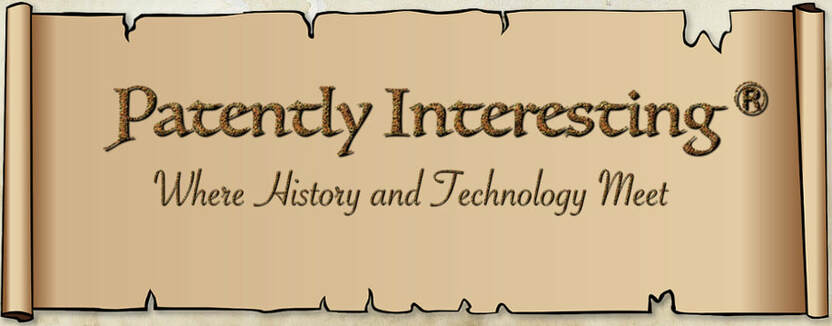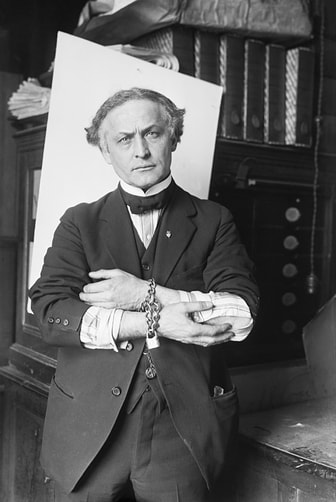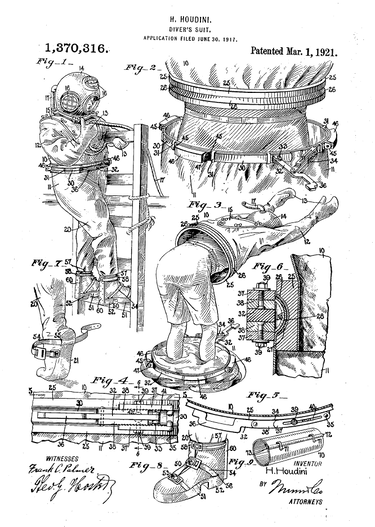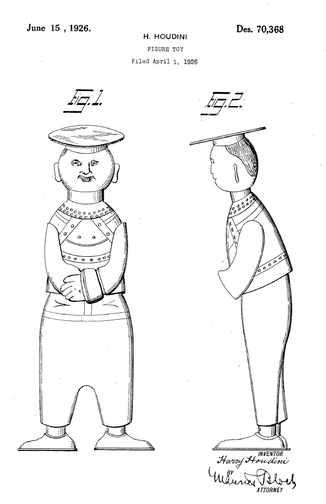He is considered one of the greatest illusionists and escape artists of all time. Most people do not know that his real name was Erik Weisz and that he was born in Hungary. Even fewer people know that he fiercely guarded the secrets of his illusions and that he did so using intellectual property rights. His stage name was Harry Houdini, a name that has become synonymous with magic.
Erik Weisz was born on March 24, 1874 in Budapest, Hungary to Rabbi Mayer Sámuel Weisz and Cecília Steiner. The Weisz family emigrated to the United States in 1878 and initially moved to Appleton, Wisconsin. Later, the family relocated to New York City. Erik had six siblings, one of whom was Theodore, who was also an accomplished magician. Theodore performed under the stage name Theodore Hardeen, or simply "Hardeen".
When he was 17, Erik conjured up the name "Harry Houdini" from a modified amalgamation of Erik's nickname, "Ehrie" (Harry) and the last name of the famous French magician, Jean Eugène Robert-Houdin ("Houdini"). While Houdini was impressed by Houdin as a youth, he later attacked Houdin as being a liar and a fraud in a book Houdini wrote called The Unmasking of Robert-Houdin, which was published in 1908. This attack presaged Houdini's later crusade to debunk psychics and mediums.
Houdini started his magic career with a friend, Jacob Hyman, in an act called the Brothers Houdini. Later, Jacob would be replaced by Harry's real brother, Theodore, who, in turn, was replaced by Wilhelmina Beatrice "Bess" Rahner. Bess would later become Houdini's wife and worked as his stage assistant until the end of Houdini's career.
Houdini's career took off in 1899 when he met Martin Beck at a St. Paul Minnesota beer hall, where Houdini was performing. Beck managed a chain of vaudeville theatres called the Orpheum Circuit. After seeing Houdini make several handcuff escapes, Beck was impressed enough to book Houdini to perform on the Orpheum Circuit. It was on the Orpheum Circuit that Houdini learned that audiences were most interested in his escape acts, so this is the area that Houdini concentrated on.
Erik Weisz was born on March 24, 1874 in Budapest, Hungary to Rabbi Mayer Sámuel Weisz and Cecília Steiner. The Weisz family emigrated to the United States in 1878 and initially moved to Appleton, Wisconsin. Later, the family relocated to New York City. Erik had six siblings, one of whom was Theodore, who was also an accomplished magician. Theodore performed under the stage name Theodore Hardeen, or simply "Hardeen".
When he was 17, Erik conjured up the name "Harry Houdini" from a modified amalgamation of Erik's nickname, "Ehrie" (Harry) and the last name of the famous French magician, Jean Eugène Robert-Houdin ("Houdini"). While Houdini was impressed by Houdin as a youth, he later attacked Houdin as being a liar and a fraud in a book Houdini wrote called The Unmasking of Robert-Houdin, which was published in 1908. This attack presaged Houdini's later crusade to debunk psychics and mediums.
Houdini started his magic career with a friend, Jacob Hyman, in an act called the Brothers Houdini. Later, Jacob would be replaced by Harry's real brother, Theodore, who, in turn, was replaced by Wilhelmina Beatrice "Bess" Rahner. Bess would later become Houdini's wife and worked as his stage assistant until the end of Houdini's career.
Houdini's career took off in 1899 when he met Martin Beck at a St. Paul Minnesota beer hall, where Houdini was performing. Beck managed a chain of vaudeville theatres called the Orpheum Circuit. After seeing Houdini make several handcuff escapes, Beck was impressed enough to book Houdini to perform on the Orpheum Circuit. It was on the Orpheum Circuit that Houdini learned that audiences were most interested in his escape acts, so this is the area that Houdini concentrated on.
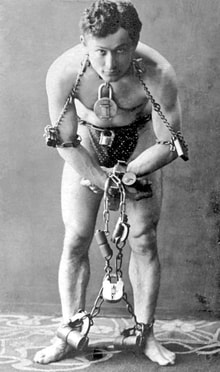
At the time, escape acts were mainly performed by spiritualist mediums who claimed they had supernatural help in freeing themselves from handcuffs, locked cabinets and rope binding. Houdini took a different tack. Instead of evoking the supernatural, Houdini invoked strenuosity and the criminal element. Houdini attributed his escape abilities to his extensive athletic training and his knowledge of techniques used by professional burglars. Houdini was not shy to exhibit his muscular physique, and he performed a number of escapes while semi-nude. Several of these risque escapes were from jails, where he was handcuffed inside locked cells.
In order to keep ahead of the competition, which often copied him, Houdini routinely introduced new escapes, each one seemingly more impossible than the preceding one. In 1908, Houdini introduced the "milk can escape", which utilized an over-sized milk can that was just large enough to hold someone of Houdini's size, who was folded into a fetal position. In the act, the milk can would be filled to the top of its neck with water. After being handcuffed, Houdini would climb into the milk can, causing water to splash out of the can and onto the stage. He would then submerge and assume a fetal position, after which the can was closed with a lid that was padlocked to the neck of the can. A curtain was pulled around the can and two minutes later Houdini would emerge from behind the curtain, dripping wet and out of breath.
In order to keep ahead of the competition, which often copied him, Houdini routinely introduced new escapes, each one seemingly more impossible than the preceding one. In 1908, Houdini introduced the "milk can escape", which utilized an over-sized milk can that was just large enough to hold someone of Houdini's size, who was folded into a fetal position. In the act, the milk can would be filled to the top of its neck with water. After being handcuffed, Houdini would climb into the milk can, causing water to splash out of the can and onto the stage. He would then submerge and assume a fetal position, after which the can was closed with a lid that was padlocked to the neck of the can. A curtain was pulled around the can and two minutes later Houdini would emerge from behind the curtain, dripping wet and out of breath.
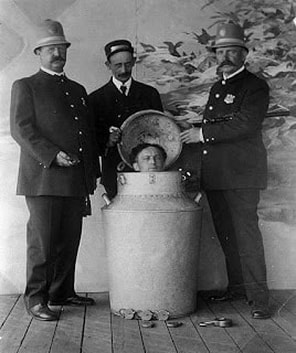
Houdini would later modify the milk can escape by having the padlocked can placed inside a large iron-bound wooden chest that was also padlocked. With this added obstacle, Houdini required an extra minute to escape. Also, in one of the early instances of cross-marketing, Houdini would, on occasion, have the can filled with beer from a local brewery, which would be advertised to the audience. On one such occasion, Houdini had one of the few mishaps of his career when the fumes from the beer caused him to pass out.
Even though the milk can escape was physically demanding, Houdini referred to it as "the first challenge he has ever presented that was mechanical". What Houdini meant by this was that the escape relied on the special construction of the milk can, something he had invented. In this regard, Houidini considered himself an inventor and compared himself to George Stephenson, Thomas Alva Edison and Guglielmo Marconi. Like these inventors, Houdini wanted to protect his inventions from copiers. Initially, he tried to obtain such protection through patents.
Even though the milk can escape was physically demanding, Houdini referred to it as "the first challenge he has ever presented that was mechanical". What Houdini meant by this was that the escape relied on the special construction of the milk can, something he had invented. In this regard, Houidini considered himself an inventor and compared himself to George Stephenson, Thomas Alva Edison and Guglielmo Marconi. Like these inventors, Houdini wanted to protect his inventions from copiers. Initially, he tried to obtain such protection through patents.
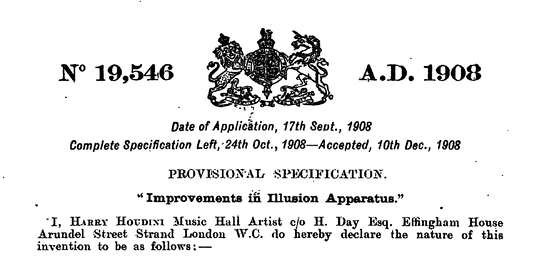
An early attempt by Houdini at obtaining a patent was a British patent application (No. 14327) he filed in 1900 for aspects of his handcuff escape act. However, he let this patent application go abandoned. Later, in 1908, Houdini filed a British patent application (No. 19,546) for aspects of his milk can escape act. The invention Houdini claimed in the '546 patent was:
"An illusional arrangement, in which a person, possibly bound, is enclosed in a receptacle, from which he will liberate himself, such receptacle being filled with a liquid and provided with means for producing a clear space above the surface of the liquid, without forcing or breaking the locks of the receptacle."
In other words, the milk can escape relied on a mechanism to increase the interior volume of the can to produce a breathing space in the neck of the can. The patent application discloses several different mechanisms for doing so. One of these is constructing the milk can in two parts: a1 and a2 that can be moved relative to each other to increase the interior volume. Fake rivets could be formed in the can to distract onlookers from discovering its two-part construction.
"An illusional arrangement, in which a person, possibly bound, is enclosed in a receptacle, from which he will liberate himself, such receptacle being filled with a liquid and provided with means for producing a clear space above the surface of the liquid, without forcing or breaking the locks of the receptacle."
In other words, the milk can escape relied on a mechanism to increase the interior volume of the can to produce a breathing space in the neck of the can. The patent application discloses several different mechanisms for doing so. One of these is constructing the milk can in two parts: a1 and a2 that can be moved relative to each other to increase the interior volume. Fake rivets could be formed in the can to distract onlookers from discovering its two-part construction.
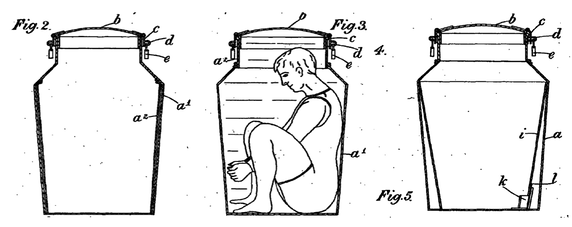
In one embodiment, the part a2 is an outer part and is telescopically disposed over the inner part a1 (shown in Fig. 2). In another embodiment, the part a1 is a main body of the can and the part a2 is the neck of the can, which is threaded over the part a1 (shown in Fig. 3). By partially unscrewing the part a2, the neck of the can may be extended and by completely unscrewing the part a2, the can may be completely opened and the person may escape from inside.
Another mechanism for increasing the interior volume of the can is to provide the can with a double wall construction in its bottom portion, with a space between the walls (shown in Fig. 5). A small panel or door closes an opening in the inner wall. By opening the panel, liquid inside the can flows into the space, thereby increasing the overall interior volume of the can and forming a breathing space in the neck of the can.
Apparently, in real life, Houdini had the milk can constructed such that an upper, neck portion of the can was wedged over a bottom, body portion of the can, like in the '546 patent. The rivets on the neck portion were fake, also as noted in the patent. As a further deterrent to discovery, the outside of the neck was lightly greased so that nobody inspecting the can could get a good grip on it. Thus, the neck was difficult, if not impossible, to remove from the outside, but could be removed from the inside by sliding it upward with the application of moderate force.
Since a patent requires disclosure of how an invention works, using a patent to protect an escape act was undesirable because it revealed the secret of the act. It is unsurprising then that Houdini lost interest in using patents to protect his escape acts. Instead, Houdini turned to copyright to protect them. He treated his escape acts as plays and registered copyrights for them as works of the performing arts. That way he prevented other magicians from performing his acts, while not having to reveal his secrets.
While Houdini stopped filing for patents for his escape acts, he did not stop obtaining patents for his other inventions. On March 1, 1921, Houdini received U.S. Patent No.: 1,370,316 for a two-piece diving suit. And less than seven months before his death on October 31, 1926, Houdini received U.S. Design Patent No.: 70,368 for a doll, appropriately enough dressed in a straight jacket.
Another mechanism for increasing the interior volume of the can is to provide the can with a double wall construction in its bottom portion, with a space between the walls (shown in Fig. 5). A small panel or door closes an opening in the inner wall. By opening the panel, liquid inside the can flows into the space, thereby increasing the overall interior volume of the can and forming a breathing space in the neck of the can.
Apparently, in real life, Houdini had the milk can constructed such that an upper, neck portion of the can was wedged over a bottom, body portion of the can, like in the '546 patent. The rivets on the neck portion were fake, also as noted in the patent. As a further deterrent to discovery, the outside of the neck was lightly greased so that nobody inspecting the can could get a good grip on it. Thus, the neck was difficult, if not impossible, to remove from the outside, but could be removed from the inside by sliding it upward with the application of moderate force.
Since a patent requires disclosure of how an invention works, using a patent to protect an escape act was undesirable because it revealed the secret of the act. It is unsurprising then that Houdini lost interest in using patents to protect his escape acts. Instead, Houdini turned to copyright to protect them. He treated his escape acts as plays and registered copyrights for them as works of the performing arts. That way he prevented other magicians from performing his acts, while not having to reveal his secrets.
While Houdini stopped filing for patents for his escape acts, he did not stop obtaining patents for his other inventions. On March 1, 1921, Houdini received U.S. Patent No.: 1,370,316 for a two-piece diving suit. And less than seven months before his death on October 31, 1926, Houdini received U.S. Design Patent No.: 70,368 for a doll, appropriately enough dressed in a straight jacket.

